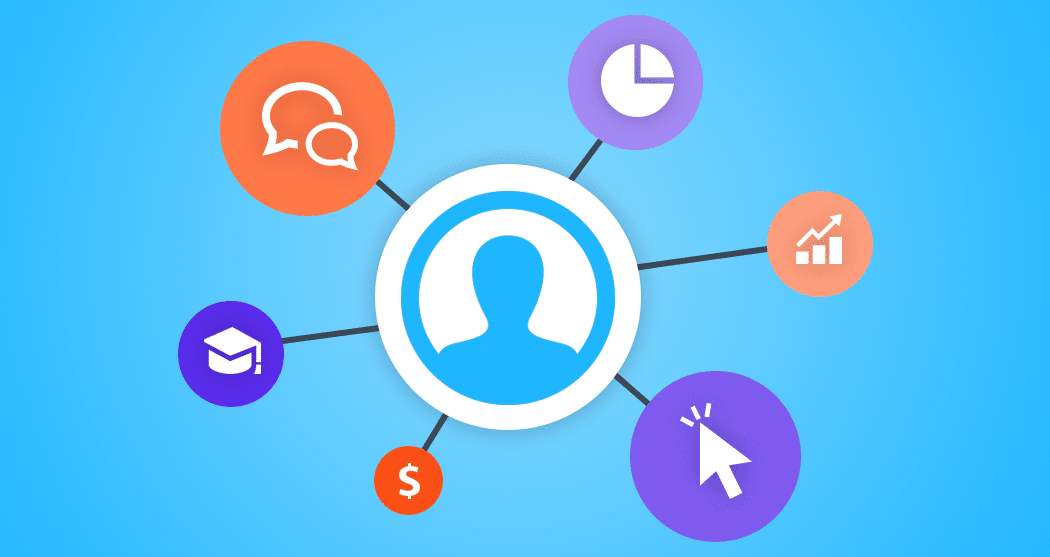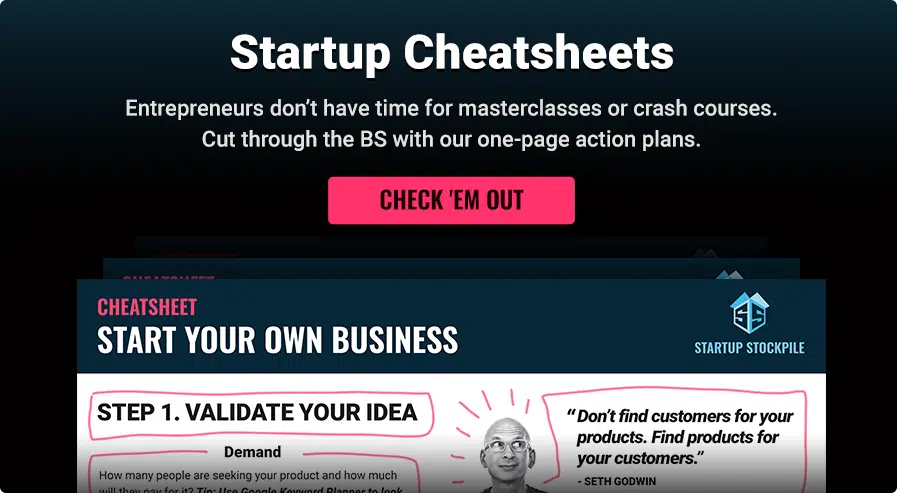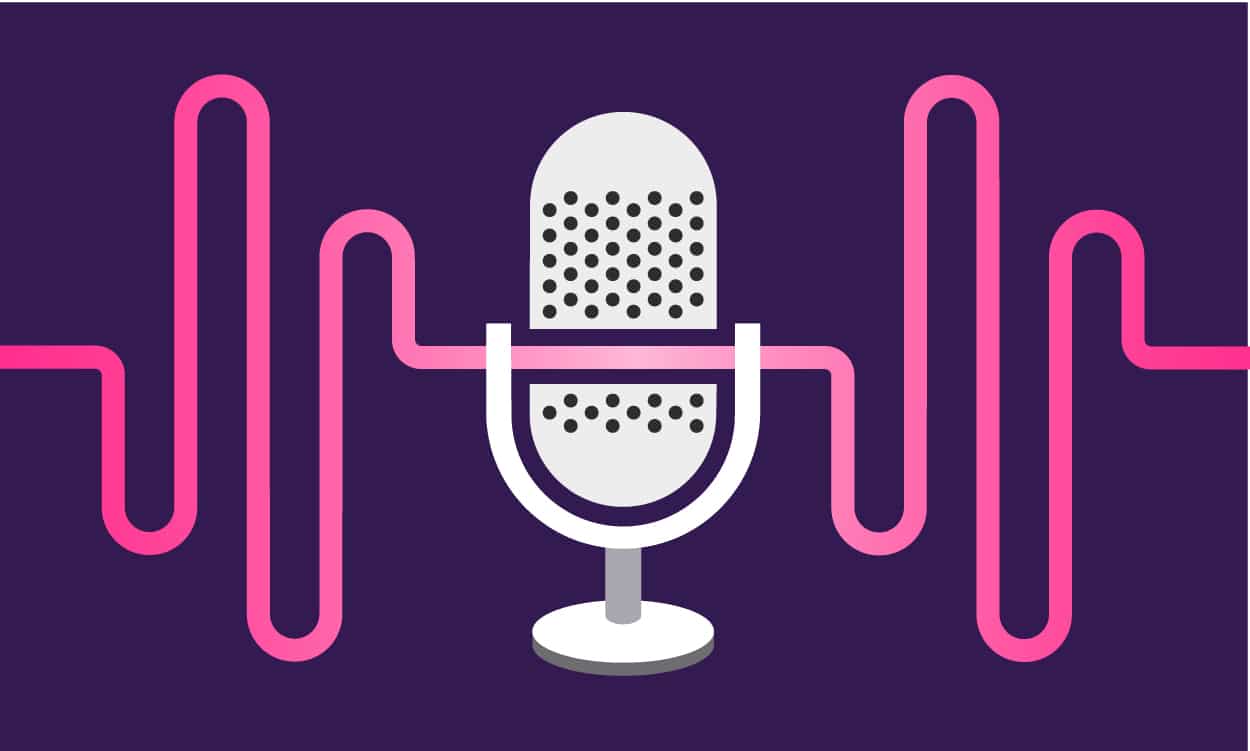A popular saying in business goes, “Put yourself in your customers’ shoes.”
This mindset is useful no matter what you sell because understanding who your target customers are takes the guesswork out of marketing.
Think about it. How much money would you save if you could better target your ads? Would your A/B testing be more accurate and take less time? Could you increase conversions by identifying exactly who wants to buy your product?
This brings us to the subject of this article — crafting a buyer persona or ideal customer profile (ICP) if you’re selling B2B.
What’s the difference (ICP vs buyer persona)?
Typically, your ideal customer profile outlines the type of organization you should try to sell to, and your buyer persona describes the person who buys from you.
But both ICPs and buyer personas help you better identify the decision-makers in your target market. And knowing who that is ensures you create promotions, sales pitches, and content that resonates with potential customers.
In this quick guide, we’ll cover everything you need to know about building your own ICPs and buyer persona and how to use them to get more (better qualified) leads.
Let’s get started.

What Are Buyer Personas?
Buyer personas are semi-fictional representations of your target audience.
They tell the story and background about the customers you want to attract.
Buyer personas include things like:
- Demographics (age, gender, income)
- Goals or objectives
- Challenges
- Pain points
- Interests
- Lifestyle
Having a buyer persona helps you keep your content, promotions, and products aligned with the needs and interests of your target customer.
Depending on the diversity of your customer base, you may have more than one buyer persona.
What Are Ideal Customer Profiles?
An Ideal customer profile (ICP) is an outline of the organization your ideal customer operates. An emphasis is “ideal”. The kind of customer that costs the least to acquire stays with you for a long time and becomes an advocate for your brand.
ICPs include things like:
- What industry (or industries) are they in?
- How many people are in the company?
- Where are they located?
- How old is the company?
- Are there any organizational changes that could affect their propensity to buy?
- Do they have partnerships that make them easier to sell to?
- What is their business model (i.e., B2B or B2C)?
In a nutshell, your ICP describes the organization that would get significant value from your product or service and provides substantial value to your company in return.
How To Build A Buyer Persona & ICP
Now that you have a general idea of what goes into ICPs and buyer personas let’s build some and put them into action.
Step 1. Start With A Template
Identifying which characteristics to include in your buyer personas can be a challenge. Fortunately, starting with a free template can serve as a guide and speed up the process.
Here are 5 templates you can use.
Template #1: HubSpot’s Buyer Persona ⇲
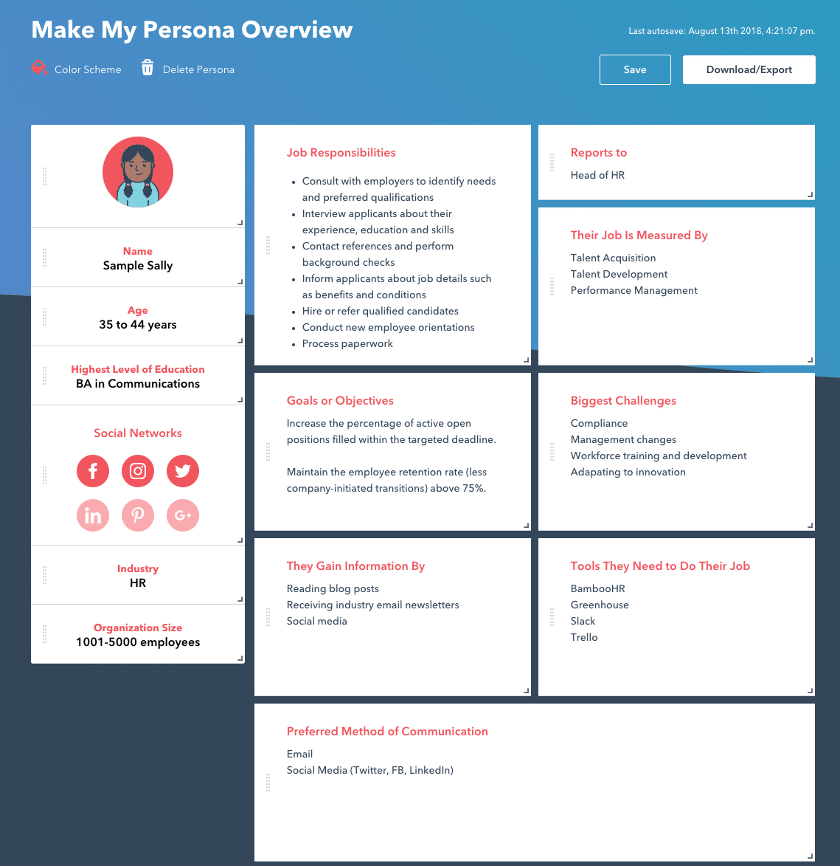
Template #2: Mirasee’s Customer Profile ⇲
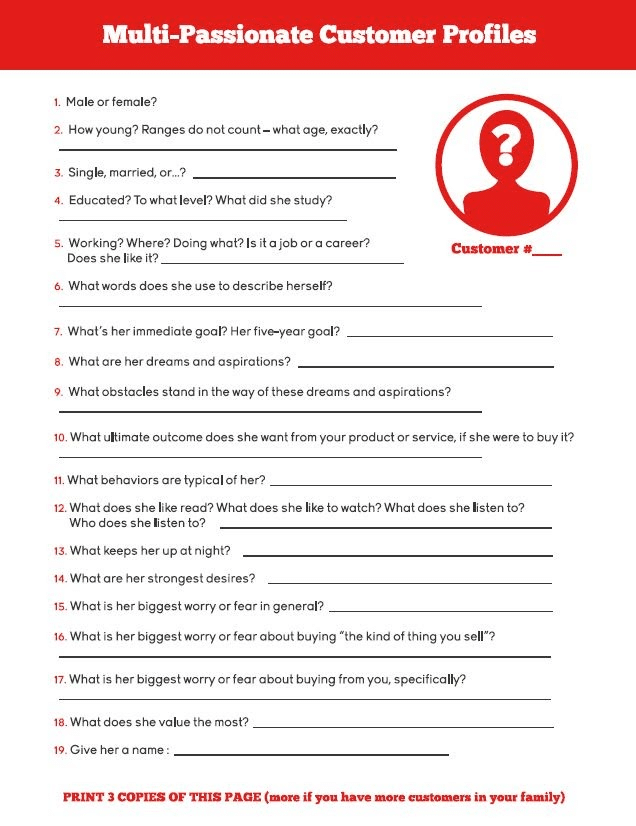
Template #3: Xtensio’s User Persona Type ⇲
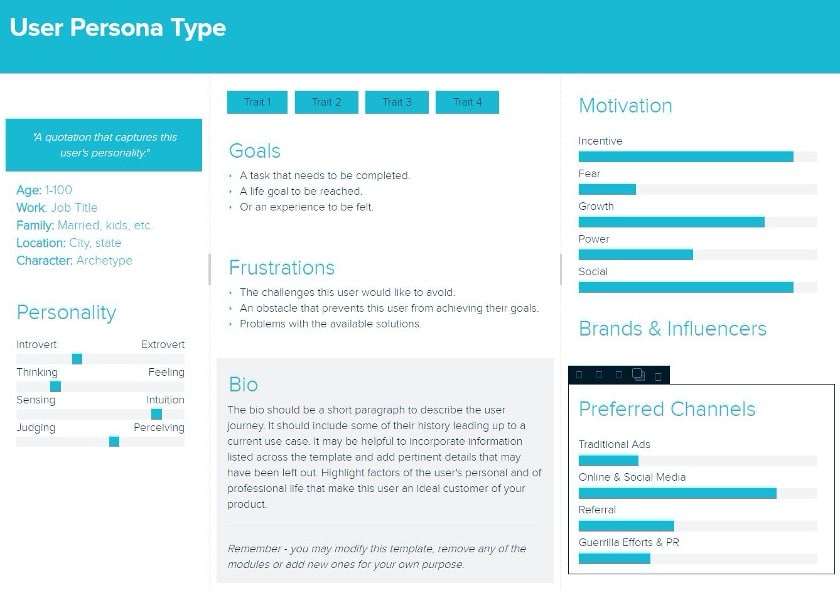
Template #4: Hootsuite’s User Persona Type (Google Sheets) ⇲
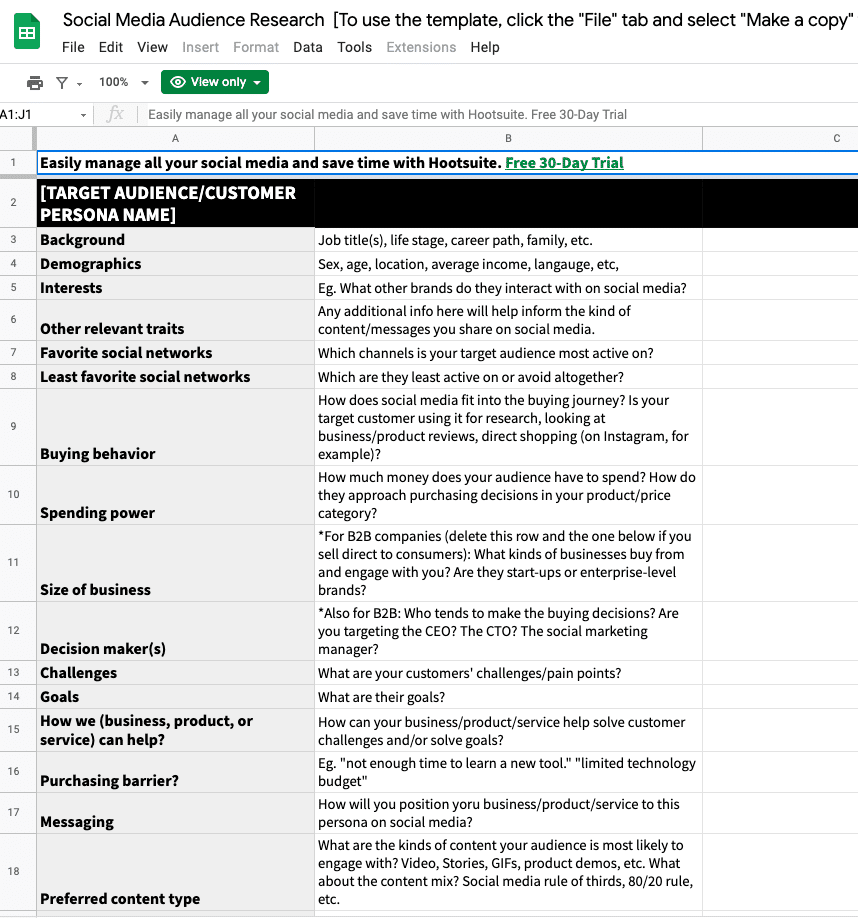
Template #5: Kalungi’s ICP (Google Slides) ⇲
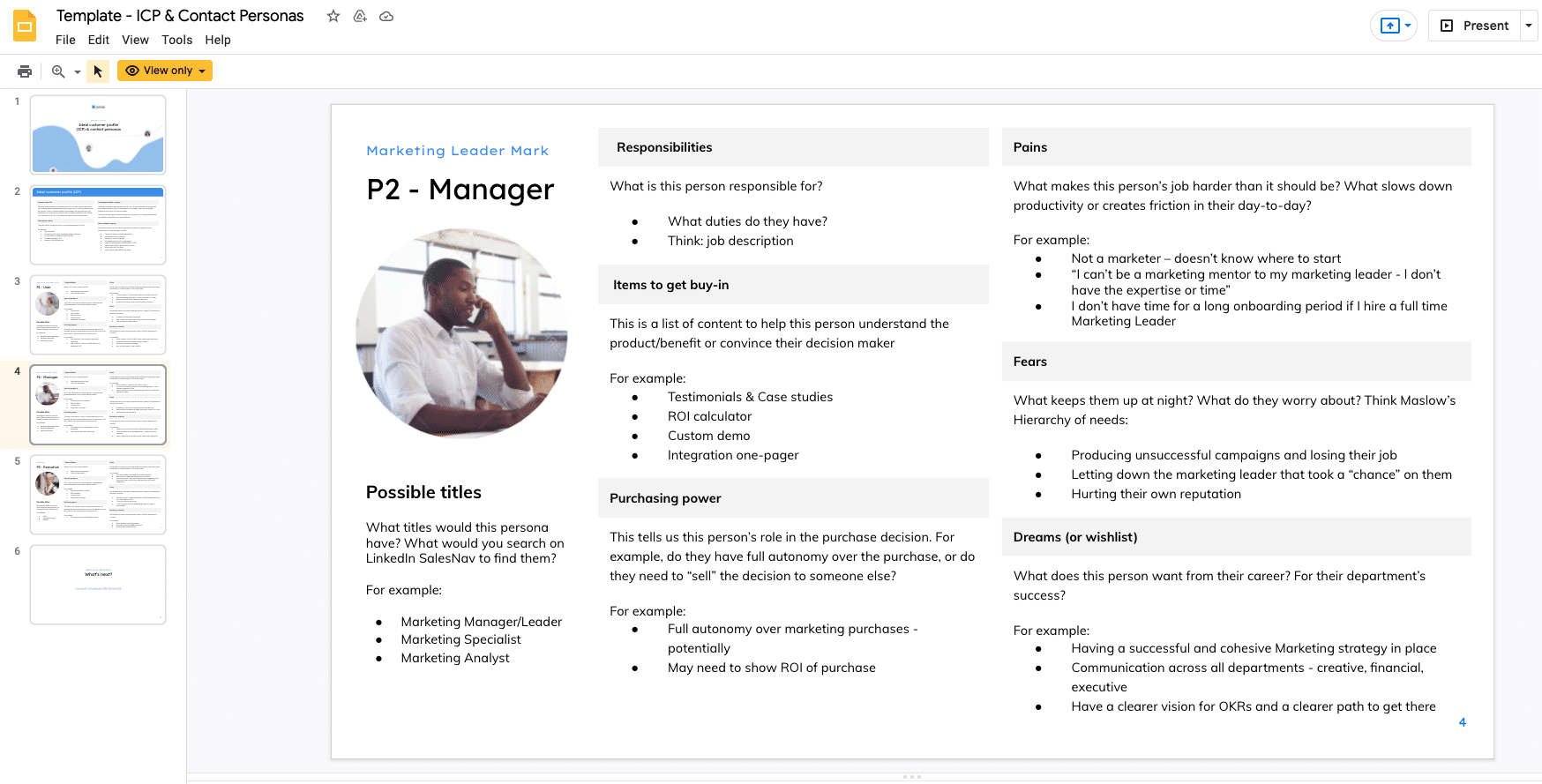
Step 2. Get To Know Your Customers
Building an accurate customer profile entails getting to know your customer base.
Here are some methods you can use to generate insights:
- Consult with client-facing employees: Contact employees like salespeople and customer support teams. Due to their consistent interactions with customers, they are likely to identify trends and know information about the consumers transacting with your business.
- Use customer relationship management tools (CRMs): CRMs provide a general overview of your consumers’ demographic, psychographic, and buying behavior.
- Conduct a survey: Your current customers are the ideal respondents for your survey. They’re the people who benefit from your products, so their feedback is crucial to the growth of your business. Tools like Google Forms can help you create and launch a survey. Consider offering incentives like small discounts or freebies to get more responses.
- Conduct interviews: Interviews allow you to interact with people in your buyer personas and learn their thoughts. Besides interviewing your brand advocates, get in touch with unhappy customers. Their insights can reveal patterns or issues you should resolve to get more leads.
- Consult marketing research agencies: Marketing research agencies specialize in generating insights and providing a general overview of your customer base.
Evaluate your sales funnel and think about how you can get customer feedback from each touchpoint. More customer feedback means more ways to improve your buyer personas.
Step 3. Use Segmentation
Put your customer profiles into action by sharing them with your marketing team.
Segment your customer base for email marketing, notifications, and content promotion strategies. By crafting personalized email marketing strategies based on the profile where customers belong, you increase chances for conversion and repeat purchases.
A study by Mailchimp found that segmented campaigns led to 14.31% higher open rates than non-segmented campaigns.
Other research found that 80% of consumers are more likely to purchase when brands offer personalized experiences.
Step 4. Tailor Your Sales Pitch
Encourage the sales team to craft cold call scripts based on buyer personas.
Keep in mind quotes from interviews that highlight your target audience’s concerns and pain points. Then, brainstorm the sales objections they may bring up and ways your sales team can persuade them to convert.
Reminding your sales teams to keep the customer profile on the back of their mind is crucial to closing deals. This way, they’re more likely to get more leads and persuade them to move across the sales funnel.
How do you do it?
Use Dan Kennedy’s “10 Smart Market Diagnosis and Profiling Questions.”
The questions Dan uses are as follows:
- What keeps them awake at night, indigestion boiling up their esophagus, eyes open, staring at the ceiling?
- What are they afraid of?
- What are they angry about? Who are they angry at?
- What are their top three daily frustrations?
- What trends are occurring and will occur in their business or lives?
- What do they secretly, ardently desire most?
- Is there a built-in bias to the way they make decisions? (Example: engineers = exceptionally analytical.)
- Do they have their language?
- Who else is selling something similar to them, and how?
- Who else has tried selling them something similar, and how has that effort failed?
Step 5. Don’t Forget To Update
Over time, the needs and interests of your customers will change.
Update your ICPs and buyer personas to ensure they’re still relevant. Conduct surveys or interviews yearly to ensure you know market changes and trends.
Accurate customer profiles make you more likely to create strategies to resonate with your target audience and get more leads.
As a result, your business will grow and generate more sales. You’ll also be able to build products and services that will better satisfy the needs of your ICPs and buyer personas.
Editor’s Note: The article is part of the blog series Grow Your Business, brought to you by the marketing team at Unitel, the virtual phone system priced and designed for startups and small business owners.


